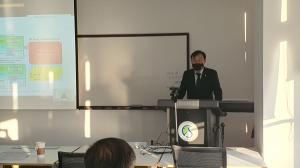Speed of development of domestic LNG storage tank PA-UT inspection standards

[에너지데일리 조남준 기자] Korea Gas Safety Corporation is accelerating the development of non-destructive (PA-UT) experts and development of the domestic LNG storage tank PA-UT inspection standards.
Korea Gas Safety Corporation (President Hae-jong Lim) conducted a phase-array ultrasound inspection (PA) at the Human Resources Training Center of Sungkyunkwan University College of Natural Sciences (Suwon City) for 4 nights and 5 days from 22nd to 26th. -UT: Phased Array Ultrasonic Testing)
This training is due to the increasing demand for ultrasonic testing techniques such as ultrasonic testing (UT) or phased array ultrasonic testing (PAUT).
Radiographic testing (RT), which was mainly conducted in the past, has been revised (December 2013) and the Nuclear Safety Act has been revised so that RT can be performed only under limited conditions as radiation safety regulations have been strengthened due to problems such as radiation exposure. This is because there are points that are difficult to apply in.
In addition, when there is no RT Room, the use of radiation is strictly limited, and the intensity of use of the radiation source is limited from 50Ci to 20Ci.
Therefore, it is required to introduce a technology to replace these radiographic tests. In December 2020, with the research team of Professor Sung-Jin Song of Sungkyunkwan University, the KTO meets international standards (API, ASME, etc.) Research was initiated with the aim of developing standards and training programs for experts. The project is scheduled to be carried out by November 2022.
The first basic training contents include an overview of ultrasonic testing, procedures and methods for verifying ultrasonic testing skills, domestic and international application cases, signal analysis of ultrasonic testing acquisition data, and defect evaluation.
President Lim Hae-jong visited the training site and said, “Many technologies that go beyond the existing methods are being developed recently, and the level of safety required at the site of diagnosis is gradually increasing.” “We will try to improve our diagnostic technology by accepting the new technology.”
In addition, he urged them to make every effort to develop non-destructive inspection technology for large gas storage facilities.
On the other hand, KDHC is planning to cultivate PA-UT experts by conducting in-depth training for primary education targets from July.
Copyright © Energy Daily Unauthorized reproduction and redistribution prohibited
